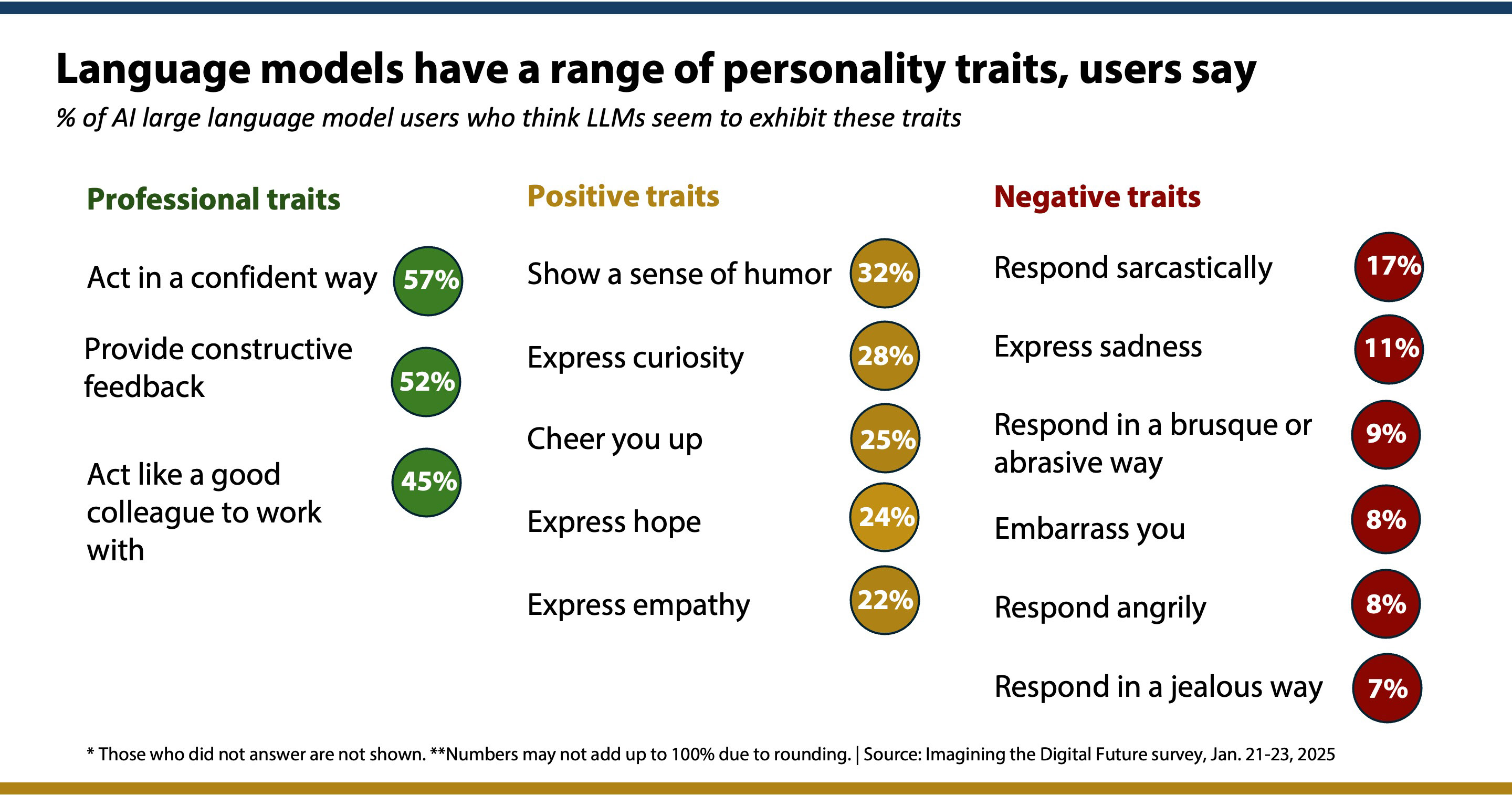A national survey by Elon University’s Imagining the Digital Future Center shows the growth and spread of artificial intelligence systems can be seen across many dimensions of the U.S. population.
Half of Americans now use artificial intelligence large language models like ChatGPT, Gemini, Claude and Copilot, according to a new national survey by Elon University’s Imagining the Digital Future Center. This makes LLMs one of the fastest – if not the fastest – adopted technologies in history.
- Full report: “Close Encounters of the AI Kind: The increasingly human-like way people are engaging with language models”
The growth and spread of these AI systems can be seen across many dimensions of the U.S. population. Younger, well-educated, relatively wealthy, and employed adults are somewhat more likely than others to be using LLMs now. Yet, it is also the case that half of those living in households earning less than $50,000 (53%) use the tools. Moreover, Hispanic adults (66%) and Black adults (57%) are more likely than White adults (47%) to be LLM users.
The other major trend captured in the survey is the extent to which these LLM users say they have human-like encounters with these tools and the sense of some users that the models have personality traits that are both pleasing and dismaying. For instance, among LLM users:
- 65% say they have had spoken conversations with back-and-forth interactions with LLMs, including 34% who regularly do this at least several times a week.
- 49% think the models they use are smarter than they are.
- 40% say the LLM they use most acts like it understands them at least some of the time.
- 32% say it seems to have a sense of humor.
- 25% say it acts like it makes moral judgments about right and wrong.
At the same time …
- 50% of LLM users say they have felt lazy when they use LLMs.
- 35% have felt they were cheating.
- 35% have felt frustrated or confused.
- 33% have felt they were becoming too dependent on LLMs for answers rather than thinking through things themselves.
“By any measure, the adoption and use of LLMs is astounding. I am especially struck by the ways these tools are being woven into people’s social lives,” said Lee Rainie, director of the Imagining the Digital Future Center. “Indeed, that’s a big surprise in these findings. Contrary to the picture that many have about how LLMs are used, our survey shows that the share of those who use the models for personal purposes significantly outnumber those who use them for work-related activities.”

Here are some of other key findings about LLM usage and impact:
- 51% of LLM users say the main purpose for their LLM use is personal, informal learning, compared with 24% who say the main purpose is for work activities.
- 34% use an LLM at least once a day, including 10% who say they use the tools “almost constantly.” Another 18% say they use LLMs several times a week.
- 72% have used ChatGPT, while 50% have used Google’s Gemini, 39% have used Microsoft’s Copilot, 20% have used Meta’s LLaMa, 12% have used xAI’s Grok, 9% have used Anthropic’s Claude and 9% say they have used other LLMs.
- 54% say their use of LLMs has improved their productivity a lot or somewhat.
- 50% say their use of LLMs has improved their ability to learn new skills and concepts a lot or somewhat.
- 42% say their use of LLMs has improved their creativity a lot or somewhat.
Other human-like interactions and relationships with LLMs, among users:
- 57% say the main LLM they use seems to act in a confident way at least some of the time.
- 25% say the LLM they primarily use cheers them up.
- 22% say their primary LLM seems to express empathy.
- 23% say they made a significant mistake or bad decision by relying on information generated by LLMs (23%).
- 21% felt manipulated by the LLM (21%).
- 9% of LLM users said the main purpose they use LLMs is for social kinds of encounters like casual conversation and companionship.
- 7% say the main model they use seems to respond in a jealous way.
Special uses of LLMs
The survey covered a host of particular uses of LLMs and found that: Two-thirds use them like search engines; about half use them for brainstorming ideas and summarizing documents; a third use them to create presentations and plan things like trips; and a quarter use them for planning social gatherings and writing computer code. In addition, 23% have used LLMs to look up what the models say about people they know, while 18% have looked up what a model says about themselves.
Future expectations about the impact of LLMs on people’s daily lives
These LLM users render mixed judgments about how these models will evolve and affect the quality of people’s daily lives in the future: 28% believe the effect overall will be more positive than negative; 20% think it will be more negative than positive; 32% think there will be an equal mixture of positive and negative impacts.
Asked about a variety of outcomes in the next decade, people are mostly positive about these:
- 62% think it is very or somewhat likely that the spread of LLMs will lead to major new medical and scientific breakthroughs.
- 55% say it is likely LLMs will be controlled by human beings and responsive to human needs.
LLM users are more negative about these future outcomes:
- 63% think it is very or somewhat likely that the spread of LLMs will cause social isolation by replacing a lot of human-to-human communication.
- 59% think it is likely that the models will cause a significant loss of jobs, even after counting the new jobs that are created.
- 53% say LLMs will likely surpass human intelligence in most important ways.
- 45% think the models will contribute to serious social upheaval.
- 40% believe LLMs will likely develop their own identity and goals.
These LLM users also predict some general impacts:
- 45% think the spread of LLMs in the next decade will considerably change the way they spend their leisure time.
- 40% think the models will dramatically change the kind of work they do.
- 38% think LLMs will form deep relationships with people.
“These findings start to establish a baseline for the way humans and AI systems will evolve together in the coming years, particularly as we draw nearer and nearer to artificial general intelligence,” Rainie said. “These tools are increasingly being integrated into daily life in sometimes quite intimate ways at the level of emotion and impact. It’s clearly shaping up as the story of another chapter in human history.”
Poll Methodology
The survey was conducted among 500 language model users drawn from the SSRS national sample between Jan. 21-23, 2025, and has a margin of error of +/- 5.1 percentage points. The full methodology and topline findings can be found here.




